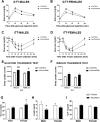Gestational saccharin consumption disrupts gut-brain axis glucose homeostasis control in adolescent offspring rats in a sex-dependent manner
- PMID: 40524248
- PMCID: PMC12172230
- DOI: 10.1186/s13293-025-00724-5
Gestational saccharin consumption disrupts gut-brain axis glucose homeostasis control in adolescent offspring rats in a sex-dependent manner
Abstract
Background: Certain events that occur in early life, such as changes in nutrition, can promote structural and functional modifications in brain development, projecting to either short, medium, and/or long terms, resulting in metabolic programming. These effects depend on the timing, intensity, and duration of exposure, and are proposed to be the cause or contribute to chronic adult disorders. Recent studies have proposed that artificial non-nutritive sweeteners (NNS), such as saccharin, can be included as one of these developmental disruptors. Saccharin consumption during pregnancy is strongly discouraged, as it can cross through the placenta and accumulate in the fetus, potentially impacting metabolic control for life. However, the mechanisms underlying the metabolic syndrome induced by maternal NNS consumption during pregnancy are not well understood. Some studies suggest that NNS may affect sweet taste receptors in the adult's guts, leading to changes in the release of glucagon-like peptide-1 (GLP-1) and insulin. The objective of the study is to investigate whether maternal saccharin consumption during pregnancy affects the gut-brain connection, leading to alterations in insulin/GLP-1 signaling during neurodevelopment until adolescence.
Methods: Pregnant rats were administered 0.1% saccharin in drinking water throughout gestation, and the main components of the insulin/GLP-1 signaling pathway were analyzed in the plasma, small intestine and hypothalamus of the offspring after weaning. Perinatal exposure to saccharin was linked to disrupted glucose homeostasis and insulin sensitivity in both male and female offspring.
Results: We identified sex-dependent mechanisms that affected GLP-1 signaling in the intestine, associated with the expression of taste receptors and glucose transporters. These alterations affected the gut-brain axis and disrupted hypothalamic signaling associated with glucose regulation and food intake, primarily involving the GLP-1, leptin, and insulin signaling pathways.
Conclusions: These results suggest that developmental NNS exposure might contribute to the growing alteration in energy metabolism.
Keywords: Development; Gestation; Glucagon-like peptide-1; Insulin; Non-nutritive sweeteners; Saccharin; Toxicology.
© 2025. The Author(s).
Conflict of interest statement
Declarations. Ethics approval and consent to participate: Ethics approval and consent to participate involving human participants, human data or human tissue are not applicable. This manuscript involves the use of animal data and tissue. All animal procedures were conducted in strict adherence to ARRIVE guidelines and the principles of laboratory animal care (National Research Council, Neuroscience CoGftUoAi, Research B, 2003) following the European Community Council Directive (63/2010/UE) and the Spanish Directive (RD52/2013). All animal procedures were approved by the Ethical Committee of the Complutense University of Madrid (PSI-2012-35388; January 2012). Consent for publication: Not applicable. Competing interests: The authors declare no competing interests.
Figures





Similar articles
-
The Effect of Non-Nutritive Sweetened Beverages on Postprandial Glycemic and Endocrine Responses: A Systematic Review and Network Meta-Analysis.Nutrients. 2023 Feb 20;15(4):1050. doi: 10.3390/nu15041050. Nutrients. 2023. PMID: 36839408 Free PMC article.
-
Preclinical Evidence of the Effects of Sweet Flavors: Sweetness Increases Nicotine Intake and Seeking.Nicotine Tob Res. 2025 Mar 24;27(4):666-675. doi: 10.1093/ntr/ntae241. Nicotine Tob Res. 2025. PMID: 39413033
-
Maternal ingestion of cannabidiol (CBD) in mice leads to sex-dependent changes in memory, anxiety, and metabolism in the adult offspring, and causes a decrease in survival to weaning age.Pharmacol Biochem Behav. 2025 Feb;247:173902. doi: 10.1016/j.pbb.2024.173902. Epub 2024 Oct 29. Pharmacol Biochem Behav. 2025. PMID: 39481653
-
Body Fat Distribution and Glucose Homeostasis Is Affected by Perinatal Exposure to High Dietary Advanced Glycation End Products (AGEs) in Male Offspring.Am J Reprod Immunol. 2025 Apr;93(4):e70073. doi: 10.1111/aji.70073. Am J Reprod Immunol. 2025. PMID: 40190117
-
Poor maternal nutrition during gestation in sheep alters key hormonal systems involved in energy homeostasis and appetite in the offspring.Domest Anim Endocrinol. 2025 Apr;91:106907. doi: 10.1016/j.domaniend.2024.106907. Epub 2024 Dec 10. Domest Anim Endocrinol. 2025. PMID: 39681045 Review.
References
-
- Camacho-Buenrostro D, Pérez-Molina J, Vásquez-Garibay EM, Panduro-Barón JG. The association between pre-pregnancy obesity and weight gain in pregnancy, with growth deviations in newborns. Nutr Hosp. 2015;32:124–9. - PubMed
-
- Valsamakis G, Kyriazi EL, Mouslech Z, Siristatidis C, Mastorakos G. Effect of maternal obesity on pregnancy outcomes and long-term metabolic consequences. Hormones. 2015;14:345–57. - PubMed
-
- Ruanpeng D, Thongprayoon C, Cheungpasitporn W, Harindhanavudhi T. Sugar and artificially sweetened beverages linked to obesity: a systematic review and meta-analysis. QJM. 2017;110:513–20. - PubMed
MeSH terms
Substances
Grants and funding
LinkOut - more resources
Full Text Sources

